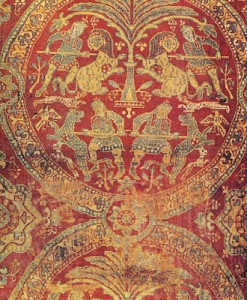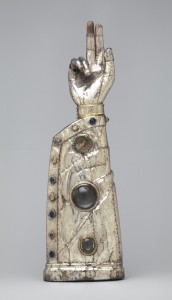Last week, I came across an article which highlights some recent textile finds in Milan. These relics are associated with the early Christian Saint Ambrose, who was elected bishop of the city of Milan in 374 C.E. What makes his burial of interest to us is that among the items kept in his honor are garment fragments. These were likely ceremonial garments that he wore during his lifetime. These delicate silk fragments give us a way of seeing more clearly into the splendid religious display of a church leader, priest and protector to emperors, and skilled political negotiator in a time where we have few other types of records.
http://www.sciencedaily.com/releases/2014/09/140902093212.htm
To put Ambrose (born Aurelius Ambrosius, c. 340 C.E.) into historical perspective, he lived only a lifetime after Emperor Constantine changed the official Roman religion to Christianity (313 C.E.) and moved the imperial capital city east to Constantinople in May of 33o C.E. Milan was a wealthy city in northern Italy, and it was sometimes used by Roman emperors in their travels as an alternate home. Ambrosius was well known to Emperors Valentinian II and Theodosius.
 Ambrosius, besides being the patron saint of Milan, which he governed, was also the patron of bees, beekeepers and candlemakers. And more useful for our needs, he was also the patron saint of children, learning, and students.
Ambrosius, besides being the patron saint of Milan, which he governed, was also the patron of bees, beekeepers and candlemakers. And more useful for our needs, he was also the patron saint of children, learning, and students.
Silk was very precious in Europe in the 4th century C.E. According to current scholarship, Byzantium and Rome were still importing all of their raw materials (reeled silk) from China and the near east. Imperial Byzantine silk-weaving workshops often held specific weaves and colors for distribution by the emperors as diplomatic gifts. Ambrose must have had considerable political importance to have been given such sumptuous garments. However, Dr. Sabine Shrenk, the archaeologist working with these textiles, suggests, as a result of this find, that silk textiles were being woven in Italy by this time, even if still from imported silk threads.
http://afghanistan.asiasociety.org/timeline/30/CE/300
“These are marvelously beautiful vestments of sumptuous silk that have been ascribed to the saint,” says Professor Dr. Sabine Schrenk of the department of Christian Archaeology at the University of Bonn. One of them has intricate depictions of hunting scenes with trees and leopards, while the other valuable textile is kept rather simple.” (Science Daily article cited above)
 Textiles woven with hunt scenes, trees, and leopards are a genre of silks associated with royalty. Lions, tigers, and leopards, have been the preferred quarry of kings since the Sassanian rulers of the 8th c. B.C.E. The motif continued to be woven for hundreds of years, and spread to Muslim workshops which produced textiles in Spain, Italy, and Syria through the 1300s.
Textiles woven with hunt scenes, trees, and leopards are a genre of silks associated with royalty. Lions, tigers, and leopards, have been the preferred quarry of kings since the Sassanian rulers of the 8th c. B.C.E. The motif continued to be woven for hundreds of years, and spread to Muslim workshops which produced textiles in Spain, Italy, and Syria through the 1300s.
Many fragments of silks with hunting themes have survived (likely because they were too valuable to make rags from). The elaborate textile in St. Ambrosius’ tomb may encourage scholars to date more of the extant, intricate examples earlier. In general, the multi-colored silks with hunters and roundels have been dated to the 7th or 8th century.
Here are some of the other hunting silks that have survived the centuries, so you can get an idea of what St. Ambrosius was dressed in:
The silk on the left was found in a reliquary in the Museum of Sacred Arts, the Vatican, Italy. The silk on the right was formerly in the tomb of St. Calmin in Mozac, and now is in the Musee des Tissus in Lyon, France. Both have been dated approximately to the 8th century C.E. Fewer silks remain from the 5th century.
The article below adds that Saint Ambrosius brought the custom of relic worship to Milan. This was an early-Christian practice where a piece of bone, hair, or some other body part associated with a holy person was kept in a church, wrapped in scraps of luxury textiles, in a richly-decorated case of some kind. Imported silk textiles were often used as wrappings because their value was properly sumptuous for these precious objects. It was believed that such objects offered the worshipper closer access to the holy person’s (e.g. Jesus, Mary, one of the apostles or saints) goodwill when the believer venerated the objects. Many churches collected such objects to give their churches greater spiritual significance. The cases housing the relics were often very highly decorated, made of precious metals, and trimmed with jewels. Here are a couple in the collection of the Metropolitan Museum of Art:
The reliquary on the left is Byzantine cloissone, late 8th century.
The reliquary on the right is French, 13th century, but added to in the 15th century.
You can read more about these here:
http://www.metmuseum.org/toah/hd/relc/hd_relc.htm
Also, a quick search in ArtStor brings up thumbnails of many more:
The author of this history blog puts Ambrosius’ bishopric into historical perspective, detailing how the saint stood up to several Roman emperors and potential invading forces, while creating his own rich court in Milan.
http://www.sciencedaily.com/releases/2014/09/140902093212.htm
In this blog, a researcher tried to imagine himself making the journey of a merchant along the silk road around Ambrose’s time.
http://www.metmuseum.org/toah/hd/coin/hd_coin.htm
These sites discuss histories of the trade routes, the spread of the silk industry throughout Europe, and other materials traded along these routes.
The Metropolitan Museum of Art did two major exhibitions on the history and art of Byzantium. We have the catalogs from these shows:
The Glory of Byzantium: Art & Culture in the Middle Byzantine Era, A.D. 843-1261, ed. by Helen C. Evans and William D. Wixom.
This is the catalog from the first big exhibition at the MMA.
Byzantium: Faith and Power (1261-1557), ed. by Helen C. Evans.
This is the catalog for the second big exhibition by the MMA.
Byzantium: from the Death of Theodosius to the Rise of Islam, by Andre Grabar.
This is an older history, but considered quite well done.
A History of Private Life, ed. by Philippe Aries and Georges Duby,
The first essay in this book is about everyday life from the Roman Empire through the Byzantine.
The Oxford History of Byzantium, by Cyril A. Mango.
This is a recently finished general history.
Studies in Silk in Byzantium, by Anna Muthesias.
Anna Muthesias is the recognized expert on Byzantine textiles and the workshops that produced them.
The Embodied Icon: Liturgical Vestments and Sacramental Power in Byzantium, by Warren Woodfin.
This title examines vestments and their meanings.





Comments
2 responses to “Old Silk, Old Roads, Old Habits”
This is fascinating. Also beautiful :). For further context, in addition to the references you give, there’s a new study of medieval clerical clothing that is a perfect example of how to study history through clothing:
Maureen C. Miller
Clothing the Clergy: Virtue and Power in Medieval Europe, c. 800 – c. 1200
Cornell University Press, 2014
Thanks! The images of the silks are so gorgeous and intricate that I had to restrain myself from posting all of the top-10 well known roundel silks 😀